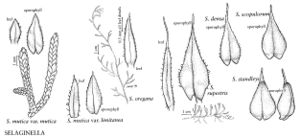Selaginella oregana
in S. Watson, Bot. California 2: 350. 1880.
Plants usually epiphytic, less often terrestrial, forming festoonlike mats. Stems radially symmetric, long-pendent, not readily fragmenting, irregularly forked, without budlike arrested branches, tips straight; main stem indeterminate, lateral branches determinate, ascending, 1-forked. Rhizophores borne on upperside of stems, restricted to base of pendent stems, or borne throughout on terrestrial stems, 0.13–0.2 mm diam. Leaves monomorphic, in alternate pseudowhorls of 4 (on main stem) and 3 (on lateral branches and secondary branches), loosely appressed, ascending, green, narrowly triangular-lanceolate to linear-lanceolate, 2–3.35 × 0.4–0.6 mm; abaxial ridges prominent, often flanked by two bands of cells (several rows wide) with whitish papillae (only in S. oregana, better seen on dry leaves); base cuneate and strongly decurrent on main stems and lateral branches or rounded and slightly decurrent to adnate on secondary branches, glabrous (seldom pubescent); margins entire or with very short cilia or denticulate, cilia few, transparent, scattered, ascending to slightly spreading, dentiform toward apex, 0.02–0.04 mm; apex slightly keeled, long-attenuate, short-bristled; bristle (hard to distinguish from apex) transparent or greenish transparent to yellowish or brownish (in old leaves), smooth, sometimes breaking off, (0.07–)0.17–0.4 mm. Strobili often paired, 1–6 cm; sporophylls lanceolate to narrowly ovate-lanceolate, abaxial ridges prominent, base glabrous, margins short-ciliate to denticulate (at middle), entire toward both base and apex, apex keeled to plane, short-bristled or merely long-attenuate.
Habitat: Pendent on trunks and branches of mossy trees (Acer macrophyllum Pursh, Populus trichocarpa Torrey & A. Gray ex Hooker, and Alnus rubra Bongard) or on deep-shaded and moist rocky banks
Elevation: 0–200 m
Distribution

B.C., Calif., Oreg., Wash.
Discussion
Selaginella oregana, one of the most distinct species in the flora, is easily distinguished by its usually long, epiphytic-pendent stems, slightly loose strobili, and curled branches (in dry specimens). In the flora, S. oregana is most closely related to S. underwoodii. It is sometimes confused with S. wallacei (see discussion), and it shares some characteristics with the Mexican species, S. extensa L. Underwood. In S. oregana, very often where a branch fork occurs, one of the branches is arrested (R. M. Tryon 1955). The strobili of S. oregana are among the longest in the flora, and they often show several novel features. Very often the apex of a strobilus undergoes a period of vegetative growth, thus becoming a vegetative shoot, and after an interval the apex reverts to the fertile condition, forming a strobilus again. In other cases, the strobilus forks, giving rise to two new strobili.
Of conservation concern.
Selected References
None.
